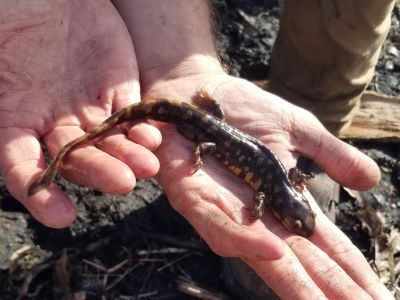
Good Natured: Signs of Spring
How good are you at reading signs?
I think most of us would agree that red octagons mean stop, yellow diamonds mean caution, and orange signs signal that everyone's favorite season, road construction, has returned.
But have you noticed that other signs too are popping up, right and left? They're subtle, yet oddly familiar, and indicate that change is underway… They're undeniable signs of spring. Here, in handy checklist form, are 10 of our naturalist department favorites:
1. Woodpeckers, both male and female, are drumming. Listen for the rapid-fire rat-a-tat of our local species as they pound on hollow trees (and siding and gutters) to declare territories and prepare for mating and nesting. It's possible to see seven different species of the family Picidae in northern Illinois. How many can you identify?
2. Daylight is lasting longer. Hard to believe, but we've added more than 120 minutes to our day length since the winter solstice back in December. Plus, March 20—the spring equinox—is just a little over two weeks away. On that date, day and night will equal each other at 12 hours apiece.
3. Canada geese are pairing off. They still prefer the safety of the flock at night, but these ever-present members of our suburban landscape have started “dating" during the day. Look for pairs feeding just ever-so-slightly away from each other as they renew their pair bonds and get ready for nesting season.
4. Mammals are on the move. Our hibernating woodchucks and bats haven't stirred yet, but mammals that spend the winter in and out of torpor (periods of inactivity) have roused and are out and about. The unmistakable scent of skunk filled the air in my neighborhood one evening last week. Wouldn't have smelled that a month ago.
5. Male redwing blackbirds have returned. Competition is stiff among these marsh denizens, which happen to be polygynous (one male, many females) and the early birds definitely claim the better territories. They'll defend them fiercely throughout the breeding season. (Remember this come June 20-something, when the news will no doubt include reports of redwing “attacks" on unsuspecting folks strolling too close to a well-hidden nest.)
6. Spiders! Next time the sun is out, find a patch of ground where the snow has melted and leaf litter is plentiful. Bet you'll find spiders there, tiny little guys and gals stalking even tinier insect prey. This is a great time to spot wolf spiders, usually noted for their great size, in smaller, immature forms.
7. Male American goldfinches are brightening. Throughout the winter months, these guys have flitted about in drab olive-yellow. But with spring just around the corner, their plumages are beginning to change. The changes start subtly, but soon these boys will be bright yellow, just as their nickname “wild canary" implies.
8. Salamanders are on the move. Each year the restoration ecologists at Hickory Knolls monitor the tiger salamander population in our natural area. Rain plus night-time temperatures above freezing bring these determined amphibians up from their subterranean lairs; then down, down they march toward the ephemeral ponds where they breed. We've counted over a dozen already, with many more to come.
9. Woolly bears are wandering. It doesn't take a lot of heat to wake up some of our overwintering caterpillars. And these iconic creatures, with their fuzzy black and brown bands, are among our most recognizable local larvae. Look for them on ice and snow, where they don't blend in at all, as well as on dried leaves, where their coloration offers a bit more camouflage.
10. Skunk cabbage is up! Our earliest blooming wildflower, Symplocarpus foetidus, has popped up in wetlands throughout the TriCities. Chemical reactions allow this plant to generate temperatures 15 to 35 degrees warmer than the surrounding air; this warmth is thought to help skunk cabbage spread its stinky (or fetid, as referenced in the Latin name) aroma as well as attract the carrion-fancying insects it requires for pollination.
I suppose we could go on, as more signs of spring are just around the corner. Soon frogs will be calling; comma, question mark and morning cloak butterflies will emerge from hibernation; and the swelling buds on our trees and shrubs will open into this year's leaves. But I'm sure your eyes are glazing over, and your attention has started to wane…both signs that it's time to stop with this talk about signs…at least for now.
Pam Otto is the outreach ambassador for the St. Charles Park District. She can be reached at potto@stcparks.org.

